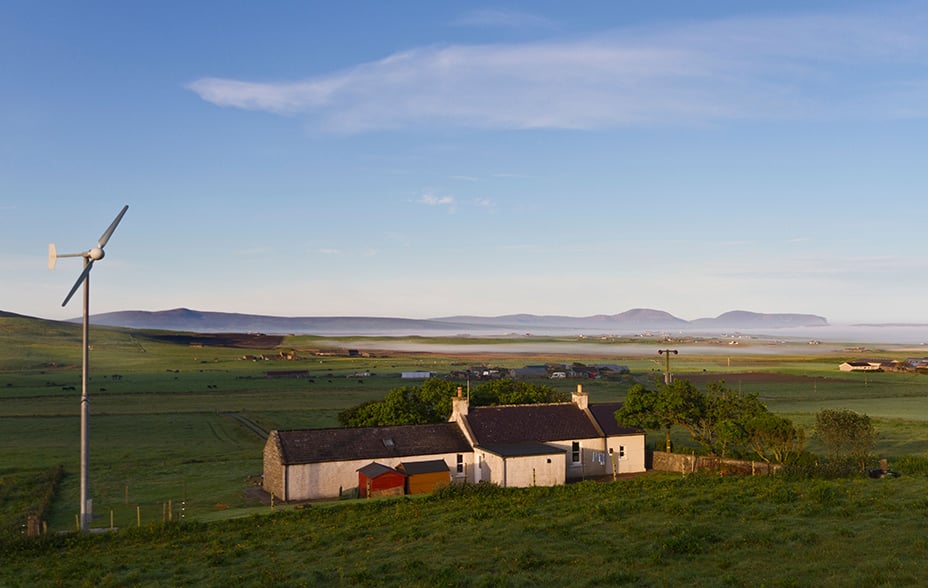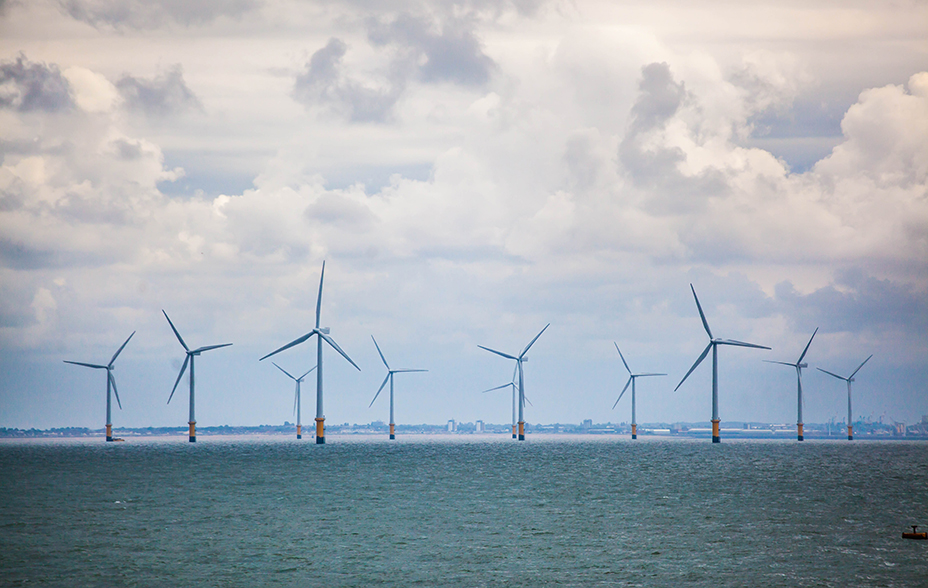
Please remember that the value of an investment can fall and you may not get back the amount invested.
A cluster of islands off Scotland’s north coast is the testbed for renewable energy technologies and new human behaviours that could be key to tackling climate change.
We visited Orkney to learn more in June. We saw first-hand how experiments there provide a path to sustainable resilience, but we also discovered regulatory roadblocks.
All of which will now feed into our decarbonisation-related investment thinking.
Heat pump and battery
Claire* lives in a weathered 18th-century house not far from the ruins of the prehistoric village Skara Brae on Orkney’s largest island, Mainland. It’s not the kind of place you would expect to glimpse the future. But look closely, and you’ll find it is piloting a host of eco-friendly innovations.
Back in 2019, as part of an award-winning trial, Claire added an integrated heat pump and battery system to the property. These allow her to maximise energy efficiency and tackle high gas and electricity costs in one of the coldest and windiest corners of the UK.
Her utility room houses a ‘phase change material’ battery. It works by drawing on heat captured by the pump to charge its contents, turning them from a solid to liquid state. It then stores the energy until needed, at which point heat is released as the process reverses. There’s virtually no energy loss or battery degradation. All of which means Claire can radically reduce her use of grid electricity.
Bearing in mind about 80 per cent of UK domestic energy use goes towards heating homes, the implications are huge if such a system can be rolled out.
Another part of the trial involves digitally linking Claire’s home to a system that uses software to adjust for changes in the wider supply and demand of locally generated renewable energy. It uses the electricity produced by Orkney’s large number of wind turbines to recharge home battery storage systems when energy generation is at its peak to avoid wasted capacity. This cuts costs and increases the islands’ resilience and independence.

Missed potential
As delighted as Claire is with her set-up, she is frustrated that efforts still fall short of their full potential. She can’t yet draw on her electric car’s battery to power her property when its own reserves are depleted, nor can she feed electricity back into the grid when others’ demand is high. Looking island-wide, without a fully smart system and the regulation to support it, Orkney’s experiments with deep electrification and efficiency risk stalling.
There’s no lack of renewable generation here. The islands have had the potential to produce more electricity than they need from their wind turbines since 2013. But up to 40 per cent of the time, the community- and commercially-owned capacity is ‘curtailed’, which involves shutting down some or all the turbines to prevent the system from overloading.
Local demand is not yet electrified or flexible enough, and there’s insufficient capacity to export all the excess power to the rest of Scotland. Not only does this limit the financial return to renewable energy developers, but it’s a wasted resource that could be heating more homes, powering more cars, and, just possibly, underpinning new energy-hungry businesses in the UK periphery.
The continued restrictions reflect the original fossil-based electricity system’s structure: highly centralised around large thermal power stations and focused on keeping the lights on in the UK’s big cities.
That can be different now. Renewable generation from wind, solar, tide and wave can come from more diverse locations. The system needs cables connecting these new points of surplus to the centres of demand. And it needs more flexibility and a pricing rethink to create local grids for decentralised power generation.

Orkney is one of those places that can go from being energy-short to energy-rich in the renewable world – and it’s banging on the central regulator’s door to get on with it!
University partnerships
Orkney’s green energy credentials are built on its fossil fuel past.
In the 1970s, a large oil terminal was constructed on the southern island of Flotta that processed as much as 400,000 barrels of crude from the North Sea a day. That was roughly enough to cover a fifth of the UK’s total need.
It encouraged Edinburgh’s Heriot-Watt University to set up a specialist campus in Orkney’s historic port of Stromness. This extended the reach of its School of Energy, Geoscience, Infrastructure and Society into renewable energy development.
In addition to pioneering research at a global level, those involved provide the local authorities with support and expertise. This can be invaluable when negotiating with the energy regulator Ofgem, the UK government and commercial developers to help ensure the islands promote and benefit from innovation.
The university is also part of a growing local ecosystem of commercial research centres, consultancies and local businesses.
One is Aquatera, a global environmental consultancy supporting on- and offshore renewable developments. It also champions local projects, including a push to encourage electric vehicle adoption.
Another is the European Marine Energy Centre (EMEC). It runs world-renowned testing sites for those developing tidal and wave power.
We visited its tidal testing site off the northern island of Eday. Though still less commercial than wind-based efforts to date, there is still significant potential in favourable sites around the world for this very predictable form of generation.

In addition to the offshore devices, this island ‘mini-grid’ has:
- An onshore wind turbine
- Electric vehicles – we were driven around in the school’s electric mini-van
- A large battery system
- A hydrogen electrolyser
It was a great opportunity to see these devices off-plan and in the field, allowing us to quiz the operators on the practicalities of installation and reliability.
Hydrogen-powered transport
Eday’s hydrogen is currently used to provide auxiliary power for some of the docked ferries at the nearby port of Kirkwall. Orkney is a major attraction for European cruise liners that bring tourists to see everything from bird life to Neolithic temples. So the next job is to get these giants off ‘bunker fuel’ – a name for the oil used by marine vessels – and onto hydrogen while in port.
Longer term, that transition could also replace fuel used for long-distance trips. Hydrogen is one of the most likely substitutes in the hard-to-decarbonise sectors of shipping, trucking and perhaps even aviation.
Here again, we found Orkney to be a testbed: the local airport has played host to both hydrogen- and battery-powered light aircraft experiments.

Eday is also where EMEC is trialling a new type of energy storage. The 1.8MWh vanadium flow battery involved can hold enough power to supply about 3,600 homes.
Vanadium is a hard silvery-grey metal that is even more abundant in the Earth’s crust than lithium but tends to be more expensive to extract. Batteries that use it are larger and more cumbersome than lithium-ion equivalents. But they benefit from much longer lifetimes and minimal fire risk, potentially making them a better choice for stationary tasks such as balancing intermittent power generated by renewables.
Geographic advantages
Orkney benefits from a favourable collision of geographical forces:
- It is one of the windiest places in Europe, onshore and offshore
- It has one of the world’s fastest tidal flows
- The islands shelter the harbour of Scapa Flow
Scapa Flow’s calm waters cover 120 sq miles. That’s six times the area of New York’s Manhattan Island, making it one of the world’s largest natural harbours. The local council and Crown Estate Scotland are planning a deep-water quay in the area to act as a hub for wind turbine assembly and maintenance. This will begin to meet the needs of one of the UK’s most exciting new industries: offshore wind.
With huge potential in its North Sea backyard and decades of experience in offshore installation and maintenance (albeit in the oil and gas sector), the UK has made marine wind generation central to its net zero strategy.
At the end of 2021, the UK was second only to China in terms of installed offshore wind capacity. And plans to quintuple the UK’s offshore power generation capacity by 2030 to 50 gigawatts, with perhaps another 100-150GW to meet the full 2050 zero carbon objective, could keep it among the leaders.
The waters off Scotland are the best place for these additions, and Orkney could be one of the critical points of assembly.
The new generation of giant turbines reach over 150 metres in height. Their various components will be shipped from all over the world and need quiet waters to be put together and then towed out to position. Scapa Flow’s new quay could be just the beginning, and there are plans for a much larger floating port.
The oil terminal at Flotta began a new chapter for Orkney in the 1970s. An offshore wind mega-hub could be the next.
Just like our visit to Eday, our on-the-ground discussions with those involved in the logistics provided a valuable reality check. We found a mix of vast potential transformation and opportunity but also challenges, whether they be the nuts-and-bolts of building stuff or addressing the justifiable concerns of stakeholders about how this activity might impact tourism, seabirds, fishing boats and more.
Historic and cultural advantages
Another factor favouring Orkney is that it only has about 22,000 residents. This makes it easier to scale experiments rapidly.
The rollout of domestic-scale wind turbines in the mid-2000s is a case in point. Residents leapt on the opportunity after being told the equipment would pay off its cost within seven years and then earn them money. At one point, the islands had 20 per cent of the UK’s small turbines despite hosting just 0.2 per cent of the population.
Thousands of years of trade and migration have also led to an openness to new ideas and integration into global supply chains. Local businesses work on projects as far afield as Indonesia and regularly collaborate with overseas counterparts involved in renewables. Even Microsoft became involved, sinking its Project Natick data centre off Orkney’s coast in 2018 as part of an experiment in hosting computer servers underwater to save on cooling costs.
There are challenges, of course. Island economies are often precarious and fragile, disproportionately reliant on a small number of industries such as tourism and oil and gas. Despite ‘headline’ full employment, underemployment is a persistent issue. It is not unusual for one person to hold multiple jobs to earn a liveable salary.
The islands also suffer harsh winters, and the generally aged-housing stock is poorly insulated. That leads to disproportionate energy demand for heating and high fuel poverty.
In Orkney, however, these challenges seem to redouble the appetite for positive change, especially when the innovations add to local resilience.
Among the wide variety of projects we saw, the main barriers frustrating further success were the ‘soft stuff’ of regulatory frameworks and approvals. While slightly depressing today, the important message is that regulatory regimes can flip overnight to enable a data-enabled world of smarter, more efficient local energy use.
Investment opportunities
So how does this affect our thinking as asset managers?
The scale of growth in wind energy in Orkney has clear implications for companies such as the turbine manufacturer Vestas and renewable power company Ørsted. And the need for infrastructure to store the energy generated could benefit Neoen – it already provides one of Australia’s largest battery storage facilities.

Other equipment makers that could gain from the trends we witnessed include:
- Power cable manufacturers, including Nexans
- Battery makers, such as CATL, Samsung SDI and LG Energy
- Electrolyser manufacturers, including ITM Power and Nel, whose kit converts renewable energy into ‘green hydrogen’
Beyond investments in individual companies, we support the UK government’s efforts to encourage pension schemes to invest in long-term green infrastructure projects of the kinds being pioneered on the Orkney Islands. We are also doing our own work on this topic in conjunction with the Chatham House think tank.
Orkney’s difficulties in balancing energy generation with usage and export are a microcosm of challenges seen worldwide as renewable energy rises as a proportion of the energy balance. And the combination of storage, regulatory changes, and decentralised energy generation that locals seem to be moving towards may indicate how others will choose to solve this problem.
Perhaps even more exciting is to look further down the track and imagine the potential for innovation and new industry that could emerge in regions freed from reliance on imported fossil fuels and replete in their own generation.
So there’s doubtless more to learn by continuing to engage with Heriot-Watt University and other organisations involved in the islands’ projects.
Ultimately, Orkney is a living laboratory.
We can all help contribute to its success by spreading the word, sharing ideas and connections, partnering, and finding opportunities for direct investment.
*Name changed to respect ‘Claire's’ personal privacy
Risk Factors
The views expressed should not be considered as advice or a recommendation to buy, sell or hold a particular investment. They reflect opinion and should not be taken as statements of fact nor should any reliance be placed on them when making investment decisions.
This communication was produced and approved in August 2022 and has not been updated subsequently. It represents views held at the time of writing and may not reflect current thinking.
Potential for Profit and Loss
All investment strategies have the potential for profit and loss, your or your clients’ capital may be at risk. Past performance is not a guide to future returns.
This communication contains information on investments which does not constitute independent research. Accordingly, it is not subject to the protections afforded to independent research, but is classified as advertising under Art 68 of the Financial Services Act (‘FinSA’) and Baillie Gifford and its staff may have dealt in the investments concerned.
All information is sourced from Baillie Gifford & Co and is current unless otherwise stated.
The images used in this communication are for illustrative purposes only.
Important Information
Baillie Gifford & Co and Baillie Gifford & Co Limited are authorised and regulated by the Financial Conduct Authority (FCA). Baillie Gifford & Co Limited is an Authorised Corporate Director of OEICs.
Baillie Gifford Overseas Limited provides investment management and advisory services to non-UK Professional/Institutional clients only. Baillie Gifford Overseas Limited is wholly owned by Baillie Gifford & Co. Baillie Gifford & Co and Baillie Gifford Overseas Limited are authorised and regulated by the FCA in the UK.
Persons resident or domiciled outside the UK should consult with their professional advisers as to whether they require any governmental or other consents in order to enable them to invest, and with their tax advisers for advice relevant to their own particular circumstances.
Financial Intermediaries
This communication is suitable for use of financial intermediaries. Financial intermediaries are solely responsible for any further distribution and Baillie Gifford takes no responsibility for the reliance on this document by any other person who did not receive this document directly from Baillie Gifford.
Europe
Baillie Gifford Investment Management (Europe) Limited provides investment management and advisory services to European (excluding UK) clients. It was incorporated in Ireland in May 2018. Baillie Gifford Investment Management (Europe) Limited is authorised by the Central Bank of Ireland as an AIFM under the AIFM Regulations and as a UCITS management company under the UCITS Regulation. Baillie Gifford Investment Management (Europe) Limited is also authorised in accordance with Regulation 7 of the AIFM Regulations, to provide management of portfolios of investments, including Individual Portfolio Management (‘IPM’) and Non-Core Services. Baillie Gifford Investment Management (Europe) Limited has been appointed as UCITS management company to the following UCITS umbrella company; Baillie Gifford Worldwide Funds plc. Through passporting it has established Baillie Gifford Investment Management (Europe) Limited (Frankfurt Branch) to market its investment management and advisory services and distribute Baillie Gifford Worldwide Funds plc in Germany. Similarly, it has established Baillie Gifford Investment Management (Europe) Limited (Amsterdam Branch) to market its investment management and advisory services and distribute Baillie Gifford Worldwide Funds plc in The Netherlands. Baillie Gifford Investment Management (Europe) Limited also has a representative office in Zurich, Switzerland pursuant to Art. 58 of the Federal Act on Financial Institutions ('FinIA'). The representative office is authorised by the Swiss Financial Market Supervisory Authority (FINMA). The representative office does not constitute a branch and therefore does not have authority to commit Baillie Gifford Investment Management (Europe) Limited. Baillie Gifford Investment Management (Europe) Limited is a wholly owned subsidiary of Baillie Gifford Overseas Limited, which is wholly owned by Baillie Gifford & Co. Baillie Gifford Overseas Limited and Baillie Gifford & Co are authorised and regulated in the UK by the Financial Conduct Authority.
China
Baillie Gifford Investment Management (Shanghai) Limited 柏基投资管理(上海)有限公司(‘BGIMS’) is wholly owned by Baillie Gifford Overseas Limited and may provide investment research to the Baillie Gifford Group pursuant to applicable laws. BGIMS is incorporated in Shanghai in the People’s Republic of China (‘PRC’) as a wholly foreign-owned limited liability company with a unified social credit code of 91310000MA1FL6KQ30. BGIMS is a registered Private Fund Manager with the Asset Management Association of China (‘AMAC’) and manages private security investment fund in the PRC, with a registration code of P1071226.
Baillie Gifford Overseas Investment Fund Management (Shanghai) Limited柏基海外投资基金管理(上海)有限公司(‘BGQS’) is a wholly owned subsidiary of BGIMS incorporated in Shanghai as a limited liability company with its unified social credit code of 91310000MA1FL7JFXQ. BGQS is a registered Private Fund Manager with AMAC with a registration code of P1071708. BGQS has been approved by Shanghai Municipal Financial Regulatory Bureau for the Qualified Domestic Limited Partners (QDLP) Pilot Program, under which it may raise funds from PRC investors for making overseas investments.
Hong Kong
Baillie Gifford Asia (Hong Kong) Limited 柏基亞洲(香港)有限公司 is wholly owned by Baillie Gifford Overseas Limited and holds a Type 1 and a Type 2 license from the Securities & Futures Commission of Hong Kong to market and distribute Baillie Gifford’s range of collective investment schemes to professional investors in Hong Kong. Baillie Gifford Asia (Hong Kong) Limited 柏基亞洲(香港)有限公司 can be contacted at Suites 2713–2715, Two International Finance Centre, 8 Finance Street, Central, Hong Kong. Telephone +852 3756 5700.
South Korea
Baillie Gifford Overseas Limited is licensed with the Financial Services Commission in South Korea as a cross border Discretionary Investment Manager and Non-discretionary Investment Adviser.
Japan
Mitsubishi UFJ Baillie Gifford Asset Management Limited (‘MUBGAM’) is a joint venture company between Mitsubishi UFJ Trust & Banking Corporation and Baillie Gifford Overseas Limited. MUBGAM is authorised and regulated by the Financial Conduct Authority.
Australia
Baillie Gifford Overseas Limited (ARBN 118 567 178) is registered as a foreign company under the Corporations Act 2001 (Cth) and holds Foreign Australian Financial Services Licence No 528911. This material is provided to you on the basis that you are a 'wholesale client' within the meaning of section 761G of the Corporations Act 2001 (Cth) ('Corporations Act'). Please advise Baillie Gifford Overseas Limited immediately if you are not a wholesale client. In no circumstances may this material be made available to a 'retail client' within the meaning of section 761G of the Corporations Act.
This material contains general information only. It does not take into account any person’s objectives, financial situation or needs.
South Africa
Baillie Gifford Overseas Limited is registered as a Foreign Financial Services Provider with the Financial Sector Conduct Authority in South Africa.
North America
Baillie Gifford International LLC is wholly owned by Baillie Gifford Overseas Limited; it was formed in Delaware in 2005 and is registered with the SEC. It is the legal entity through which Baillie Gifford Overseas Limited provides client service and marketing functions in North America. Baillie Gifford Overseas Limited is registered with the SEC in the United States of America.
The Manager is not resident in Canada, its head office and principal place of business is in Edinburgh, Scotland. Baillie Gifford Overseas Limited is regulated in Canada as a portfolio manager and exempt market dealer with the Ontario Securities Commission ('OSC'). Its portfolio manager licence is currently passported into Alberta, Quebec, Saskatchewan, Manitoba and Newfoundland & Labrador whereas the exempt market dealer licence is passported across all Canadian provinces and territories. Baillie Gifford International LLC is regulated by the OSC as an exempt market and its licence is passported across all Canadian provinces and territories. Baillie Gifford Investment Management (Europe) Limited (‘BGE’) relies on the International Investment Fund Manager Exemption in the provinces of Ontario and Quebec.
Israel
Baillie Gifford Overseas is not licensed under Israel’s Regulation of Investment Advising, Investment Marketing and Portfolio Management Law, 5755–1995 (the Advice Law) and does not carry insurance pursuant to the Advice Law. This material is only intended for those categories of Israeli residents who are qualified clients listed on the First Addendum to the Advice Law.
Ref: 25335 10013387






